The original Apple-1 was just a mainboard – nothing else. Just one exception: Steve Wozniak created afterwards the Apple-1 cassette interface. It was sold for US$ 75. Everything else was up to the owner. For this reason, there is no original Apple case, keyboard, etc. And don’t even think about a mouse.
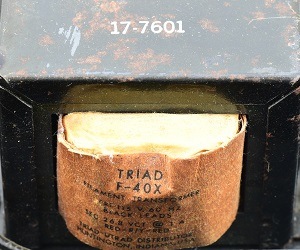 There was no power supply. Apple-1 owners had to find a solution themselves. Usually, two transformers were
used. Most Apple-1 owners used Stancor (P-8380 and P-8667) or Triad (F-31X and F-40X) transformers as recommended in the Apple-1 manual.
All wiring was up to the owner. Ready-to-use solutions were offered by some shops and Apple dealers.
There was no power supply. Apple-1 owners had to find a solution themselves. Usually, two transformers were
used. Most Apple-1 owners used Stancor (P-8380 and P-8667) or Triad (F-31X and F-40X) transformers as recommended in the Apple-1 manual.
All wiring was up to the owner. Ready-to-use solutions were offered by some shops and Apple dealers.
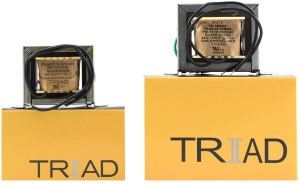
 No keyboard was ever offered by Apple for the Apple-1!
Many Apple-1 owners in 1976/77 used Datanetics Rev B keyboards. The Apple-1 needs an ASCII keyboard. Later on, and even today, many Apple-1 owners used Apple II keyboards. Nowadays some replica keyboards are available.
No keyboard was ever offered by Apple for the Apple-1!
Many Apple-1 owners in 1976/77 used Datanetics Rev B keyboards. The Apple-1 needs an ASCII keyboard. Later on, and even today, many Apple-1 owners used Apple II keyboards. Nowadays some replica keyboards are available.
The Apple-1 came onto the market without a case. Steve Jobs later had wooden cases produced first and later a metal case as a prototype.
Prototype case
 Only one prototype case exists. It was on Steve Jobs' desk office on display until 1985. It is (was) on display at the Living Computer Museum, Seattle, USA, and Apple-1 #70 in the Apple-1 Registry.
Only one prototype case exists. It was on Steve Jobs' desk office on display until 1985. It is (was) on display at the Living Computer Museum, Seattle, USA, and Apple-1 #70 in the Apple-1 Registry.
Wooden Byte Shop cases
 There are many articles about the Byte Shop cases. Most of them are based on hearsay or are simply copied and pasted or produced by ChatGPT and others.
There are many articles about the Byte Shop cases. Most of them are based on hearsay or are simply copied and pasted or produced by ChatGPT and others.
Steve Jobs, not the Byte Shop or Paul Terrell, had the first cases produced by Ralph Wigginton! It is still unclear how the enclosures were distributed. Possibly through a Byte Shop (not the first Byte Shop) or through Steve Jobs himself.
The so-called wooden Byte Shop cases are handmade and based on the work of Randy Wigginton's (Apple employee #6) brother Ralph Wigginton from California. Achim Baqué first had contact with Ralph by email and later talked to the brothers via Skype. Randy Wigginton was Apple employee #6.
According to Ralph's recollection, he made about 12-15 wooden cases for Steve Jobs. Steve Jobs was delighted but never paid Ralph for his work. Achim showed Ralph the pictures of the Byte Shop cases. At first, he thought that it was his work, but after a closer look, he was sure that the cases were a copy of his work, but not the cases he built for Jobs. This could be seen in some details.
Paul Terrell told Achim that he did not sell the cases in his store. He suspects that another of his Byte Shop stores or Steve Jobs was selling them.
Unfortunately, this still leaves the question of who built the Byte Shop cases unanswered. The assumption is that Steve Jobs had the cases built based on Ralph's design. Woz emphasized in a personal conversation with Achim that he knew nothing about cases and that Steve Jobs alone took care of the marketing. Woz worked continuously on the Apple II and had no interest or time to deal with cases. Achim has more information, but it has not yet been confirmed or is based on hearsay.
The research into the housing took months and Achim spoke to countless contemporary witnesses.
A list of all known Apple-1 with original wooden Byte Shop cases is here. The cases were made of Koa wood.
The story of the wooden Byte Shop cases is published here
Other cases
Most owners just used the computer without a case or chose custom-made cases. Owners were pretty creative when it came to the case: wooden cases, plastic cases, metal cases, 19-inch racks, briefcases, or even just a wooden board.
 The unique routed wooden case is listed in the Apple-1 Registry as #70. It was donated to the Smithsonian by Mike Williams.
The unique routed wooden case is listed in the Apple-1 Registry as #70. It was donated to the Smithsonian by Mike Williams.
It is unknown who built the case. Previous theories were that Chris Espinosa or Ralph or Randy Wigginton built the case. This is not correct. They all deny it. But there are two new theories.
Ralph Wigginton (he built for Steve Jobs the first wooden cases for the Apple-1) wrote "No idea. It could have been my brother James Robert (Robbie), has some of features that he might have included."
Chris Espinosa (Apple Employee #8) wrote „I believe Steve Headley of Homestead High School built the pictured case. I supplied the Apple I from surplus stock around the Apple lab. It’s been attributed to Randy’s brother, but Randy’s father would know that he did, and if he doesn’t claim it, then it was Headley. Steve Headley was both the computers instructor at Homestead but also taught woodshop."

The Apple-1 was delivered in a simple white cardboard box.
A few still exist.
In 1976 photos, a stack of boxes in the room of Steve Jobs' sister is visible.
Some boxes have writing or labels on top.
 Apple did not offer any monitor for the Apple-1. Some owners used monitors, some used TVs. Some used an RF modulator to get the signal through the antenna connector. A wide selection of different monitors/TVs were used. Some famous auction pictures show a square monitor, the Sanyo VM-4509 or Sanyo VM-4209.
Apple did not offer any monitor for the Apple-1. Some owners used monitors, some used TVs. Some used an RF modulator to get the signal through the antenna connector. A wide selection of different monitors/TVs were used. Some famous auction pictures show a square monitor, the Sanyo VM-4509 or Sanyo VM-4209.
For this reason, many people believe this would be THE monitor for the Apple-1. But it is not. It is just one possibility. The Sanyo monitor was shown at many auctions, and maybe for this reason so many people believe it is the 'correct' monitor.
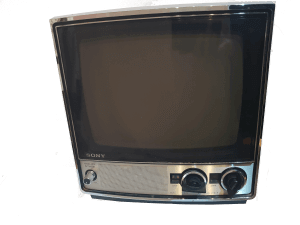
Many pictures from 1976 or 1977 show TV screens used with the Apple-1. Even pictures at Jobs' house and at the First West Coast Computer Faire show ordinary TVs.
Steve Jobs wrote about the Sony TV 115 in a letter to Electric City Radio Supply.
 Optionally, there was an interface for tape recorders available for US$ 75. It was plugged into the free slot.
BASIC and games on cassettes were available. This cassette interface was developed by Wozniak. In 1976, the speed
of 1200 baud was considered fast.
Optionally, there was an interface for tape recorders available for US$ 75. It was plugged into the free slot.
BASIC and games on cassettes were available. This cassette interface was developed by Wozniak. In 1976, the speed
of 1200 baud was considered fast.
Anyway, loading programs from a tape recorder could be quite tedious. The data transfer was not particularly
reliable. Later it was discovered that replacing a 10nF capacitor with a 100nF capacitor made it considerably
more reliable.
Two different versions of the ACI exist.

 The Apple Cassette Interface exists, like the Apple-1 itself, in two versions: 1st batch and 2nd batch (which are marked “NTI”).
Sometimes NTI Apple Cassette Interfaces are used with 1st batch Apple-1s, simply because the owner bought it later. In the beginning, no Apple Cassette Interface was available.
The Apple Cassette Interface exists, like the Apple-1 itself, in two versions: 1st batch and 2nd batch (which are marked “NTI”).
Sometimes NTI Apple Cassette Interfaces are used with 1st batch Apple-1s, simply because the owner bought it later. In the beginning, no Apple Cassette Interface was available.

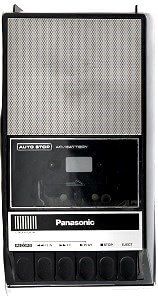 Again, many people believe the Panasonic RQ-2102 would be THE cassette recorder for the Apple-1 just because many auction
pictures show this recorder. But this type was manufactured years later. It is just a better solution than
the one Apple-1 owners had to use back in 1976. Back in 1976, the Panasonic RQ-309DS was available and recommended by Apple.
Again, many people believe the Panasonic RQ-2102 would be THE cassette recorder for the Apple-1 just because many auction
pictures show this recorder. But this type was manufactured years later. It is just a better solution than
the one Apple-1 owners had to use back in 1976. Back in 1976, the Panasonic RQ-309DS was available and recommended by Apple.

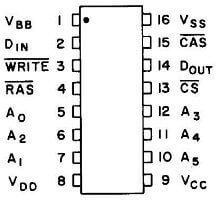 Memory was limited to 4 or 8 KB, but it was possible to upgrade it yourself. This was not an easy task, and only a few owners
added more memory. For some Apple-1s, this additional memory was later removed to make it look more original for
auctions. It is up to you to judge if this is good or bad.
Memory was limited to 4 or 8 KB, but it was possible to upgrade it yourself. This was not an easy task, and only a few owners
added more memory. For some Apple-1s, this additional memory was later removed to make it look more original for
auctions. It is up to you to judge if this is good or bad.
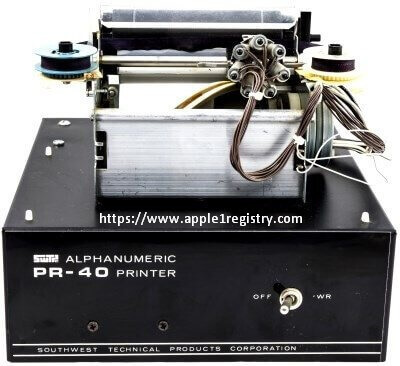 Just a few owners tried to use a printer with the Apple-1. Steve Jobs wrote an article about the SwTPC PR-40 printer and how
to use it with an Apple-1. The PR-40 has 40 columns. The paper width is 4 inches.
Just a few owners tried to use a printer with the Apple-1. Steve Jobs wrote an article about the SwTPC PR-40 printer and how
to use it with an Apple-1. The PR-40 has 40 columns. The paper width is 4 inches.
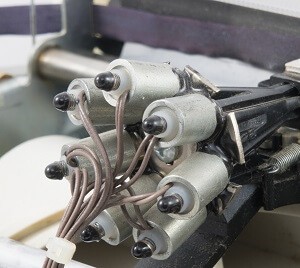
 Some owners created additional hardware for the Apple-1. Some was added directly to the mainboard, and others were added by using
the expansion connector. KIMSI was an additional board made for the KIM-1 computer and was compatible with the Apple-1.
The KIMSI allowed adding S-100 cards. S-100 was some kind of standard in the '70s and was, for example, used in Altair
and IMSAI computers. Some users even added a Teletype to the Apple-1. Another nice addition was the GT-6144 Graphics
Board. This board made it possible to use monochrome graphics. Well, the graphic resolution was only 96x64 pixels.
Some owners created additional hardware for the Apple-1. Some was added directly to the mainboard, and others were added by using
the expansion connector. KIMSI was an additional board made for the KIM-1 computer and was compatible with the Apple-1.
The KIMSI allowed adding S-100 cards. S-100 was some kind of standard in the '70s and was, for example, used in Altair
and IMSAI computers. Some users even added a Teletype to the Apple-1. Another nice addition was the GT-6144 Graphics
Board. This board made it possible to use monochrome graphics. Well, the graphic resolution was only 96x64 pixels.